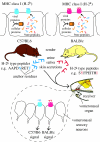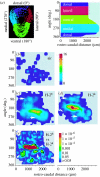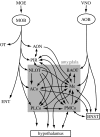Mammalian social odours: attraction and individual recognition
- PMID: 17118924
- PMCID: PMC1764843
- DOI: 10.1098/rstb.2006.1931
Mammalian social odours: attraction and individual recognition
Abstract
Mammalian social systems rely on signals passed between individuals conveying information including sex, reproductive status, individual identity, ownership, competitive ability and health status. Many of these signals take the form of complex mixtures of molecules sensed by chemosensory systems and have important influences on a variety of behaviours that are vital for reproductive success, such as parent-offspring attachment, mate choice and territorial marking. This article aims to review the nature of these chemosensory cues and the neural pathways mediating their physiological and behavioural effects. Despite the complexities of mammalian societies, there are instances where single molecules can act as classical pheromones attracting interest and approach behaviour. Chemosignals with relatively high volatility can be used to signal at a distance and are sensed by the main olfactory system. Most mammals also possess a vomeronasal system, which is specialized to detect relatively non-volatile chemosensory cues following direct contact. Single attractant molecules are sensed by highly specific receptors using a labelled line pathway. These act alongside more complex mixtures of signals that are required to signal individual identity. There are multiple sources of such individuality chemosignals, based on the highly polymorphic genes of the major histocompatibility complex (MHC) or lipocalins such as the mouse major urinary proteins. The individual profile of volatile components that make up an individual odour signature can be sensed by the main olfactory system, as the pattern of activity across an array of broadly tuned receptor types. In addition, the vomeronasal system can respond highly selectively to non-volatile peptide ligands associated with the MHC, acting at the V2r class of vomeronasal receptor. The ability to recognize individuals or their genetic relatedness plays an important role in mammalian social behaviour. Thus robust systems for olfactory learning and recognition of chemosensory individuality have evolved, often associated with major life events, such as mating, parturition or neonatal development. These forms of learning share common features, such as increased noradrenaline evoked by somatosensory stimulation, which results in neural changes at the level of the olfactory bulb. In the main olfactory bulb, these changes are likely to refine the pattern of activity in response to the learned odour, enhancing its discrimination from those of similar odours. In the accessory olfactory bulb, memory formation is hypothesized to involve a selective inhibition, which disrupts the transmission of the learned chemosignal from the mating male. Information from the main olfactory and vomeronasal systems is integrated at the level of the corticomedial amygdala, which forms the most important pathway by which social odours mediate their behavioural and physiological effects. Recent evidence suggests that this region may also play an important role in the learning and recognition of social chemosignals.
Figures




References
-
- Acharya K.K, Dominic C.J. Duration of the luteotrophic memory of the stud male odors formed in the female mouse. J. Exp. Zool. 1997;279:626–632. doi:10.1002/(SICI)1097-010X(19971215)279:6<626::AID-JEZ11>3.0.CO;2-# - DOI - PubMed
-
- Archunan G, Dominic C.J. Stud male protection of implantation food-deprived mice: evaluation of the involvement of olfactory–vomeronasal systems. Exp. Clin. Endocrinol. 1990;96:30–36. - PubMed
-
- Bellringer J.F, Pratt H.P.M, Keverne E.B. Involvement of the vomeronasal organ and prolactin in pheromonal induction of delayed implantation in mice. J. Reprod. Fert. 1980;59:223–228. - PubMed
-
- Belluscio L, Koentges G, Axel R, Dulac C. A map of pheromone receptor activation in the mammalian brain. Cell. 1999;97:209–220. doi:10.1016/S0092-8674(00)80731-X - DOI - PubMed
-
- Beynon R.J, Hurst J.L. Multiple roles of major urinary proteins in the house mouse, Mus domesticus. Biochem. Soc. Trans. 2003;31:142–146. - PubMed
Publication types
MeSH terms
Substances
Grants and funding
LinkOut - more resources
Full Text Sources
Research Materials

